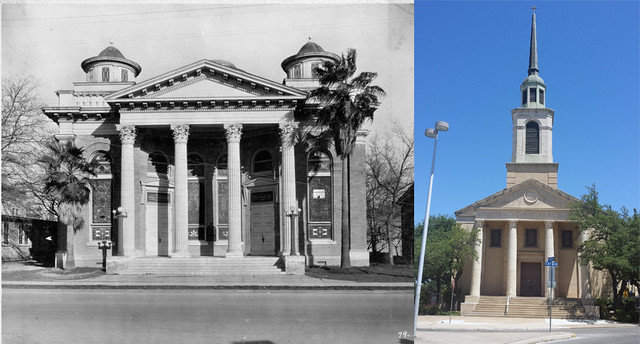
[/url][url=https://flic.kr/p/nzFQUK]583-Central Christian Church, 1927 (Romana Plaza) by Paul Bubel, on Flickr
Central Christian Church, Romana Plaza
[This message has been edited by p_bubel (edited 5/11/2014 7:29p).]

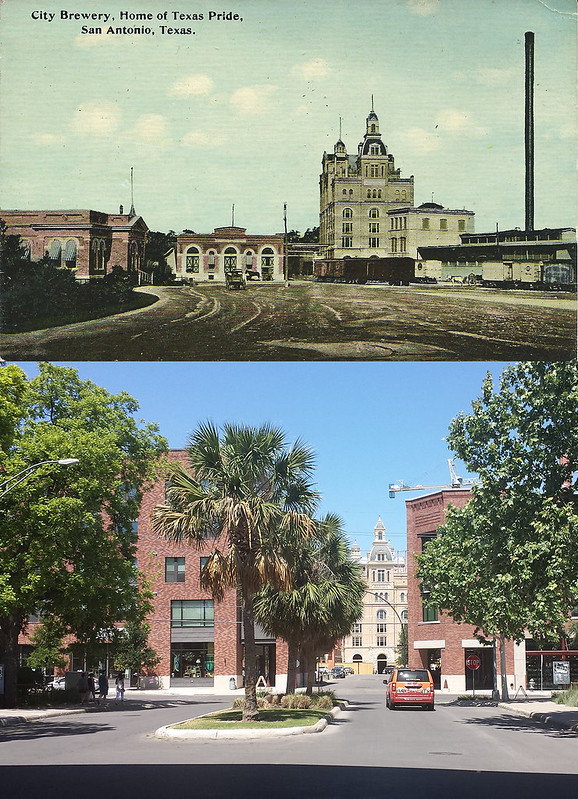
quote:
The site owned and operated by the Pearl Brewing Company was originally known as both the J. B. Behloradsky Brewery (1881–1883) and the City Brewery. Privately held and poorly run for two years, the City Brewery was purchased by an investment group in 1883. The investment group was composed of local businessmen and several moguls already involved in brewing at San Antonio's other major brewery, the Lone Star Brewing Company. Together they formed the San Antonio Brewing Company.
Pearl Beer was formulated and first brewed in Bremen, Germany, by the Kaiser–Beck Brewery, which produces Beck's beer. Pearl beer's name came from Kaiser–Beck Brewery's brewmaster, who thought the foamy bubbles in a freshly poured glass of the brew resembled sparkling pearls.[6] In Germany, the brew was called "Perle", which is the German word for pearl. When brought to the United States, the spelling was changed to the English version: pearl. In 1886, the first bottles and wooden kegs of American Pearl beer rolled off the line and into local tap rooms.


quote:
Buffalo at Breckenridge
The City Parks Commissioner, Ludwig Mahncke, was given the task of improving the land, and he lost no time. As a close friend of Brackenridge, he enjoyed the donor's full cooperation and support. Mahncke designed a series of drives totaling seven miles that wound through the trees and along the river, converging at the north end of the park. By 1902, there was a fenced deer preserve and enclosures for buffalo and elk. Animals were pastured along River Avenue near today's Lions Field, and were fed with hay raised in an adjacent pasture. Though successful and popular, Mahncke resigned in 1906 after a political dispute with Mayor Bryan Callaghan, a bitter enemy of his friend George Brackenridge. Mahncke died within several months and was honored by his friends who dedicated a monument to him that stands today in Mahncke Park.
A great history of the park can be found here:
Scroll to the bottom.

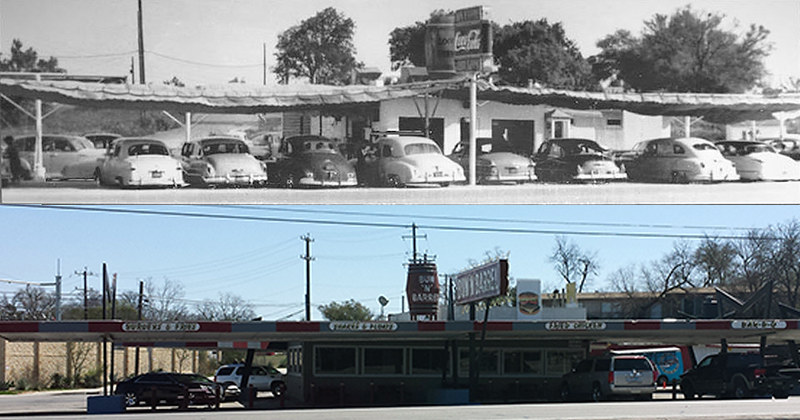

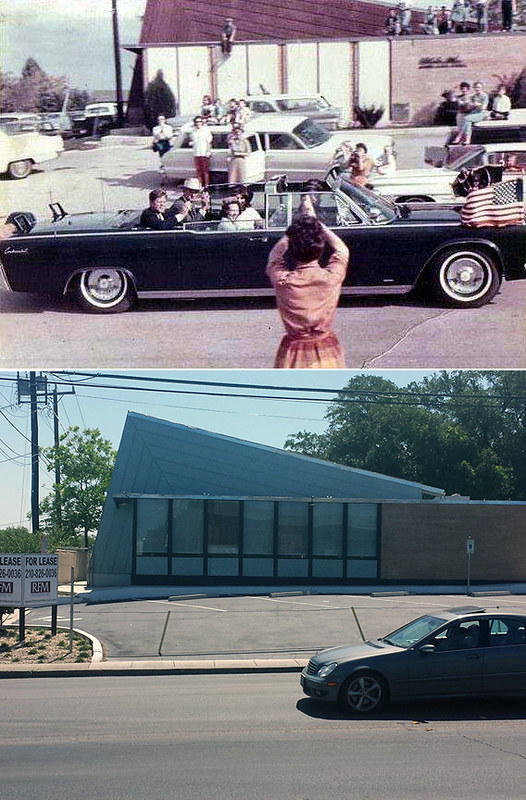


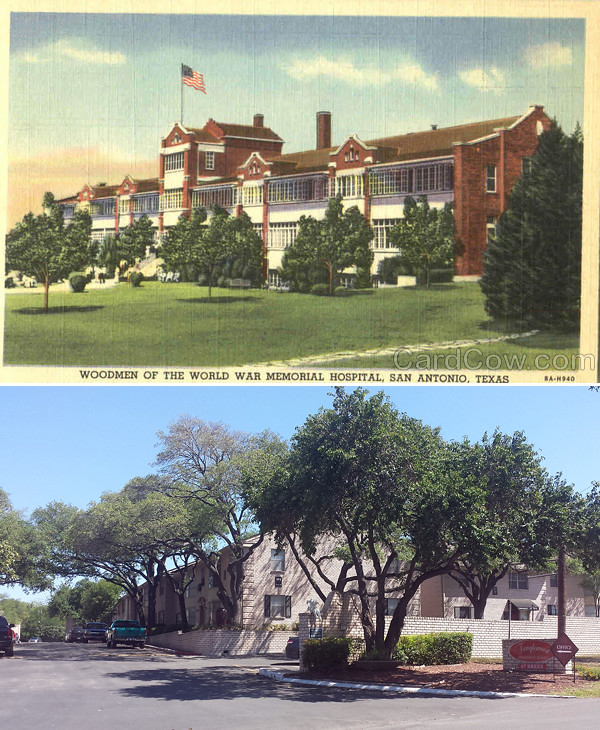
quote:
Kampmann’s story started to unfold. I found that a politically-forced emigration caused him to leave a promising career in Germany, arriving penniless because a friend had absconded with what little money he had. Having extensive skills and having worked on the famous Cathedral of Cologne, he started humbly in the New World as a stone mason with a pick and trowel. He soon bought a quarry to cut, to haul, and to build in the local creamy white limestone for homes that brought a German vernacular style to a city of adobe Spanish design.
He engaged in a business partnership with another German architect sharing commissions for a land office and a courthouse, and eventually became a prolific builder, credited in the local press with having built one-third of the entire city of San Antonio.
“High tech” for his period, Kampmann introduced the first elevator and electric bell in what was then the tallest building in the City, his legacy Lockwood/Kampmann Bank building, which, though dilapidated, still exists on West Commerce and Solidad Street.
His involvement in infrastructure advancements included development of the first utility, the San Antonio Gas Supply Co., and the first water works, the Metropolitan Water Co. He was the first to use steam power in manufacturing.
His transportation innovations included the introduction of the first trolley system, and he worked indefatigably over many years on a committee which eventually succeeded to bring in the first railroad. He rose to position of Major in the Civil War where he both fought and commanded army supply trains while running a manufacturing operation to make hats and coats for the Confederate States Army. He served the local offices of councilman and alderman, and even as a volunteer fireman.
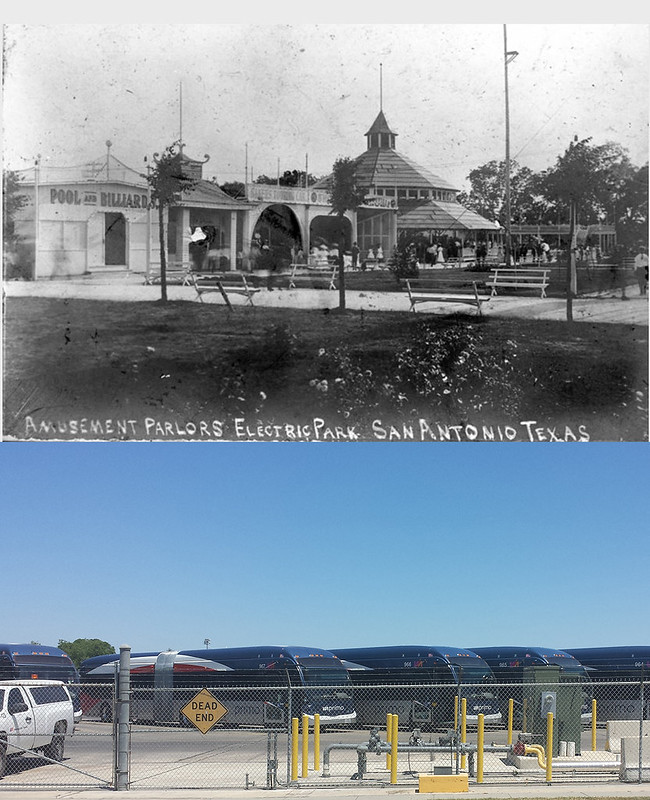
quote:
(1906) -Immediately south of San Pedro Park
Most Electric Parks were owned by electric companies and trolley companies, which often had one or more lines that transported workers and shoppers between the downtown areas of the various cities and residential and industrial areas. (After 1900, interurban electric rail lines began carrying commuters from one city to another). Originally, the trolleys and interurban lines would either operate at a reduced level on weekends or be completely idle. To generate weekend traffic, the companies eventually created new destinations, generally at the end of their lines, for the public to attend on the weekends, whether it be a picnic park or (later) an amusement park. Regardless of the type of park, the destinations owned by the local electric company or accessed by the electric trolley were commonly called electric parks.
The park site would a couple of years later become the location of one of the cities first "minor league" baseball fields.
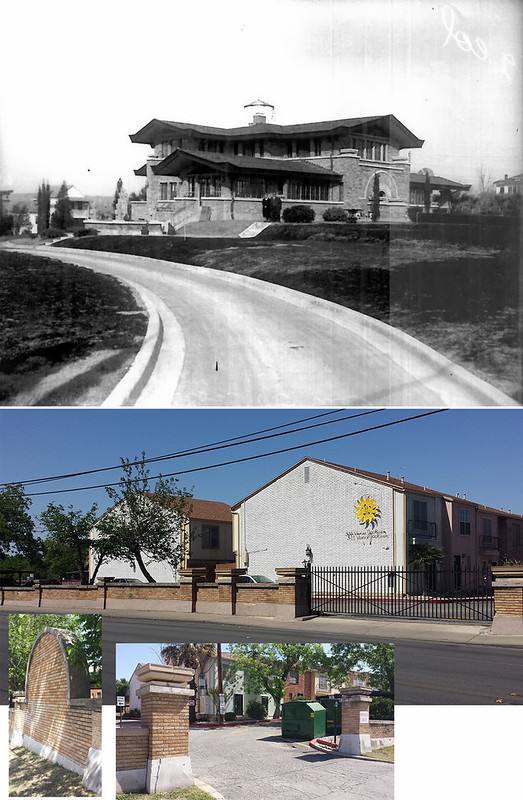
quote:
Daisy and Violet Hilton were born in Brighton, East Sussex, England on February 5, 1908 to a young, unwed barmaid, Kate Skinner. At the age of two weeks, the twins were "adopted" by Mary Hilton, their mother's landlady who was also their midwife. The sisters were pygopagus twins - conjoined at the hips and buttocks. They shared blood circulation and were fused at the pelvis but shared no major organs. Soon after acquiring the twins, Mrs. Hilton put them on exhibition. They were managed by Ike Rose of Rose's Royal Midgets fame and exhibited alongside Rosa and Josefa Blazek, probably the first time in history that two sets of Siamese twins were ever shown together. Daisy and Violet were later taken on an Australian tour with Mary Hilton, her husband Henry, and their daughter Edith. While in Australia, Edith married Myer Myers, a carnival balloon salesman.
When Mary Hilton died, she willed the twins to Edith and Myer. The Myers relocated to the United States and used part of the twins' fortune to built a luxurious, Frank Lloyd Wright-inspired home in San Antonio, Texas. Daisy and Violet spent the majority of the 1920s touring the United States on vaudeville circuits, playing clarinet and saxophone, and singing and dancing. The sisters were a national sensation, counting among their friends a young Bob Hope and Harry Houdini, who allegedly taught them the trick of mentally separating from one another.
By this time, it seems, the Hilton sisters had already become lightning rods for scandal. Seeking friendship outside the abusive Myers home, the twins befriended their advance agent, William "Bill" Oliver. Although the twins claim in their autobiography that their relationship with Oliver was strictly platonic, biographer Dean Jensen believes the twins were two of many mistresses of the smooth-talking promoter and that he slept with both of them many times. In any case, Oliver's wife Mildred accused him of "spending too much time" with them and filed for divorce, and attempted to sue the twins for $250,000. On the orders of Mrs. Myers, Daisy and Violet asked for the help of a San Antonio lawyer, Martin J. Arnold. Arnold inquired as to why the sisters, who were over 21 years old and legal adults, remained bound to Mr. and Mrs. Myers, and he was shocked to learn of their situation. He took on the twins' case in January of 1931, helping them file suit against the Myers to break their contract and legally separate from their abusive guardians. Judge W.W. McCrory decided the case in April, awarding the equivalent of nearly $80,000 to the sisters and allowing the Myers to keep their San Antonio home.
Newly emancipated, Daisy and Violet became citizens of the United States and returned to the only life they'd ever known: showbusiness. In 1932 they appeared in the movie Freaks, which dared to pose the question of whether or not conjoined twins can have a love life. Over the coming decade, it would become quite clear that the answer was yes. Violet, the more outgoing of the pair, had a string of celebrity boyfriends, including the musician Blue Steel, boxer Harry Mason, and guitarist Don Galvan, before becoming engaged in 1933 to bandleader Maurice L. Lambert. She and Lambert began a nationwide search for a clerk who would issue them a marriage license. Each of her requests - in 21 states - was denied on moral grounds, and lawyers were brought in to argue on Violet's behalf. One New York clerk refused to issue the license because Daisy was not also engaged. Though briefly engaged to Jack Lewis, another bandleader, she deemed him too shy for marriage to a Siamese twin.
Unable to get married, Violet and Maurice split. Two years later, however, the twins' agent Terry Turner announced that he could arrange for Violet to marry after all - she only needed a groom. Chosen for the role was Violet's dance partner and a longtime confidant of the twins, James Walker "Jim" Moore. The wedding, such as it was, took place on July 18, 1936, at the Texas Centennial Exposition on the 50-yard line of the Cotton Bowl. Daisy, too, got to experience wedded bliss when she married vaudeville dancer Harold Estep, stage name Buddy Sawyer, at Elmira, New York, on September 17, 1941. Their marriage lasted two weeks.
After the decline of vaudeville, the twins, like countless others, turned to Hollywood. In 1950 the sisters appeared in the film Chained for Life as Dorothy and Vivian Hamilton, vaudeville singers. In the film, Vivian takes a dislike to the musician who is courting her sister. Dorothy, on the other hand, is so smitten that she begs doctors to separate her from her twin so that she might marry. In the end, Vivian shoots and kills Dorothy's beau with a pistol grabbed from a sharpshooter's prop cart. The judge - and the audience - are left to decide whether to send innocent Dorothy to jail, or let guilty Vivian walk free.
Chained for Life was a colossal failure, banned in many places due to its lurid subject matter. Having spent nearly all of their fortune and struggling to survive, the twins opened a hotdog stand, The Hilton Sisters' Snack Bar, in Miami, in 1955, but the business failed in part due to the objections of fellow vendors who didn't like a pair of freaks stealing their business. Short on cash, having been unable to manage their showbusiness earnings responsibly, the sisters decided to bank on the cult revival of their first movie, Freaks. In 1962 they arranged to appear at a drive-in movie theater in Charlotte, North Carolina. Here they were abandoned, penniless, by an unscrupulous agent. A kind grocery store manager, Charles Reid, hired the sisters to work in his shop, where they checked and bagged groceries. Reid bought work dresses for the twins, since all they had were show clothes. On January 6, 1969, after battling the Hong Kong flu for some weeks, the twins failed to report for work. Their boss called the police and the sisters were found dead in their small trailer. Daisy died first and forensic evidence suggested that Violet lived for two to four days afterwards, although this is highly questionable since the twins shared circulation and she would have bled to death much sooner. Having no surviving family, the twins were laid to rest beside a Vietnam soldier named Troy Thompson, the son of an acquaintance. At death, the twins owned but $1,000, a far cry from their formerly vast fortune. Those who met them late in life describe the quintessential "fallen stars": the twins spoke and dressed as they had in their heyday, well into the 1960s.
[url]phreeque.tripod.com/hilton_sisters.html[/url]

quote:
(1925)
Dr. Urrutia was Dr. Aureliano Urrutia, who died in his sleep in 1975, at the age of 103. After having five wives, the fifth about 40 years younger than he, 18 children, after practicing medicine for 81 years, inventing medical procedures still used today, being one of the first surgeons to separate Siamese twins - but that's not the interesting part.
Dr. Urrutia was a Mexican political exile when he arrived in
San Antonio in 1915, in his early forties.
He'd been born into full-blood Indian poverty in 1872 in Xochimilco, the town of the floating gardens, a little south of Mexico City. By 1895 Urrutia had graduated at the top of his medical school class, sponsored by the president of Mexico himself, Porfirio Diaz. Diaz named him his personal physician at the age of 22.
Presidente Diaz got in trouble in 1910 and stepped down with his head still attached, his fortune intact - he'd been ruling for 30, 35 years if I remember right - but after Diaz, from 1910 to 1920, Mexico wasn't ruled as much as it was repeatedly raped. This was the age of bloody insurrections, clumsy intrigue, peasant revolutions, open warfare, dust and blood. Orozco, Villa, Zapata. More than once, the course of Mexico's history swiveled back and forth on the murderous impulses of drunk corporals and illiterate machine-gunners.
Diaz was replaced by a vegetarian idealist Francisco Madero in 1910, but Madero had unleashed forces that he couldn't control. He lasted about thirteen months. Madero's brother/advisor was brutally murdered, a messy killing with a sword thrust into his good eye for a first inning. Then Madero himself was openly betrayed and shot in the neck. This made way for possibly the worst president Mexico ever had, which is really saying something: a drunken military gangster named Victoriano Huerta.
Well, guess who had operated on Huerta's eyes. Guess who'd been implicated in the murder of Madero. Guess who was made Huerta's close advisor and trusted Minister of Government in 1912, and was supposedly more or less acting president. Guess who! None other than the guy who lived across the street from the old Earl Able's? Doctor Urrutia.
The one gate on Hildebrand and this one on Broadway have been taken apart and carted off to SAMA. All that remains of his medical empire is a strange, off-limits garden behind that early 60's-style office building across the street.
www.texasescapes.com/SanAntonioTx/Dr-Aureliano-Urrutia-Ti...
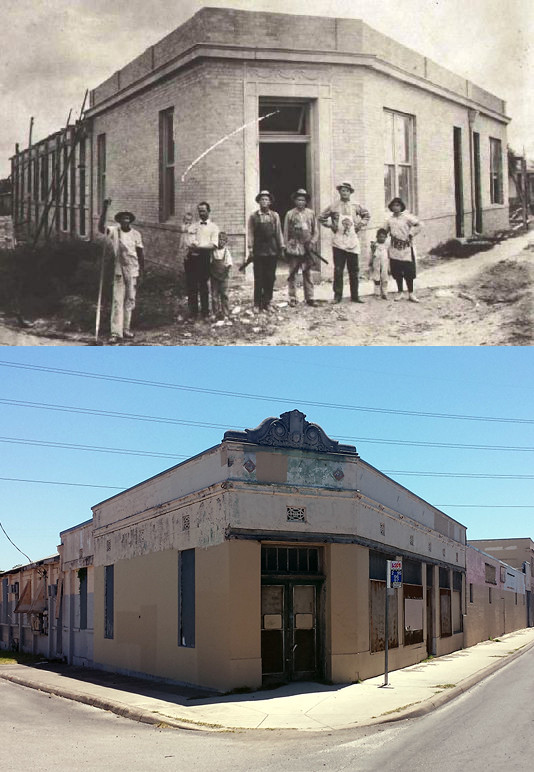
quote:
The more I look at this building the less sure it might be it, though the concrete ornamentation at the top sure could be some of his work. This has been frustrating to recreate the information I once had available, but can no longer locate. Painta, as I remember the name, was prolific in cast concrete ornamentation in San Antonio at the beginning of the last century. You can find his work in such places as the Jordan Ford Dealership shown above and the Jefferson High School on the near west side."]The more I look at this building the less sure it might be it, though the concrete ornamentation at the top sure could be some of his work.
This has been frustrating to recreate the information I once had available, but can no longer locate. Painta, as I remember the name, was prolific in cast concrete ornamentation in San Antonio at the beginning of the last century. You can find his work in such places as the Jordan Ford Dealership shown above and the Jefferson High School on the near west side.
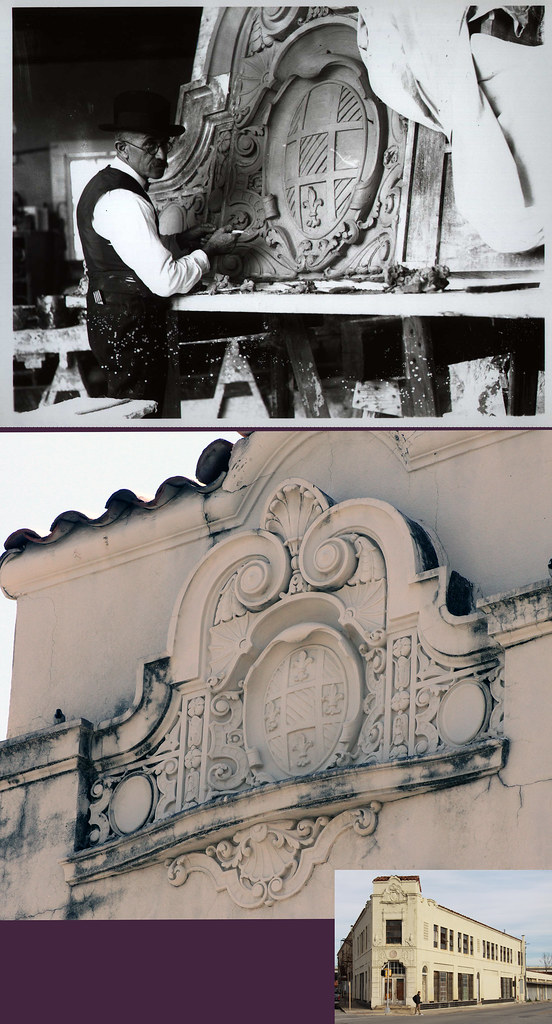
quote:
This has been frustrating to recreate the information I once had available, but can no longer locate. Painta, as I remember the name, was prolific in cast concrete ornamentation in San Antonio at the beginning of the last century. You can find his work in such places as the Jordan Ford Dealership shown above and the Jefferson High School on the near west side. His studio was on Fredericksburg Rd, and I think still standing."]This has been frustrating to recreate the information I once had available, but can no longer locate. Painta, as I remember the name, was prolific in cast concrete ornamentation in San Antonio at the beginning of the last century. You can find his work in such places as the Jordan Ford Dealership shown above and the Jefferson High School on the near west side. His studio was on Fredericksburg Rd, and I think still standing.
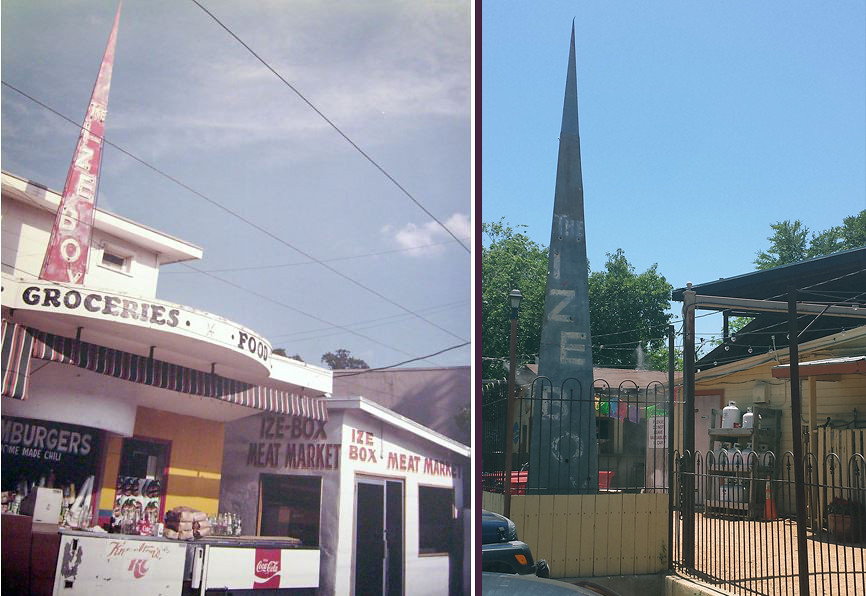
quote:
The Ize Box on Broadway. From what I can gather there were two locations, and the blue sign is from that other store. (It is now located at the rear entrance to Tycoon Flats) Information is limited and I really have nothing other to add. Bah."